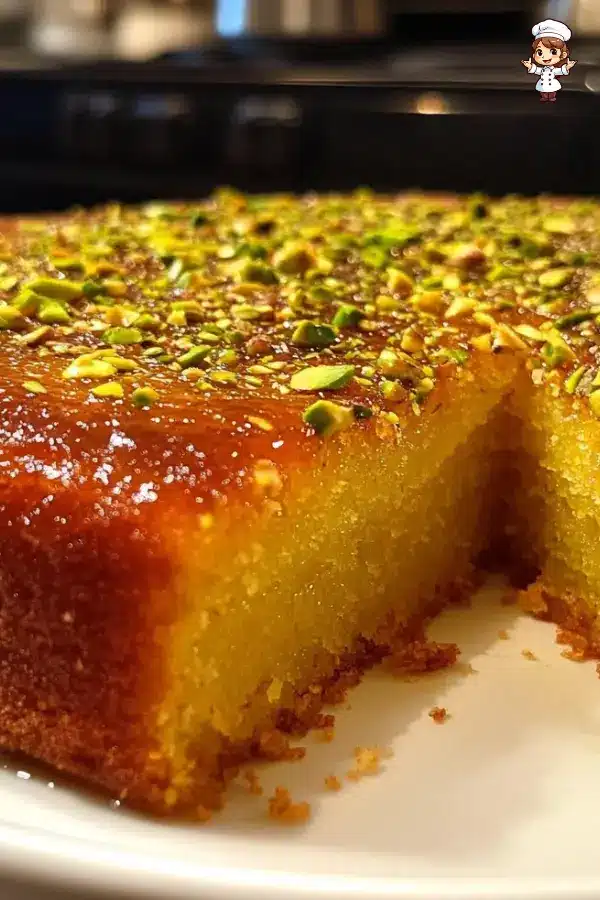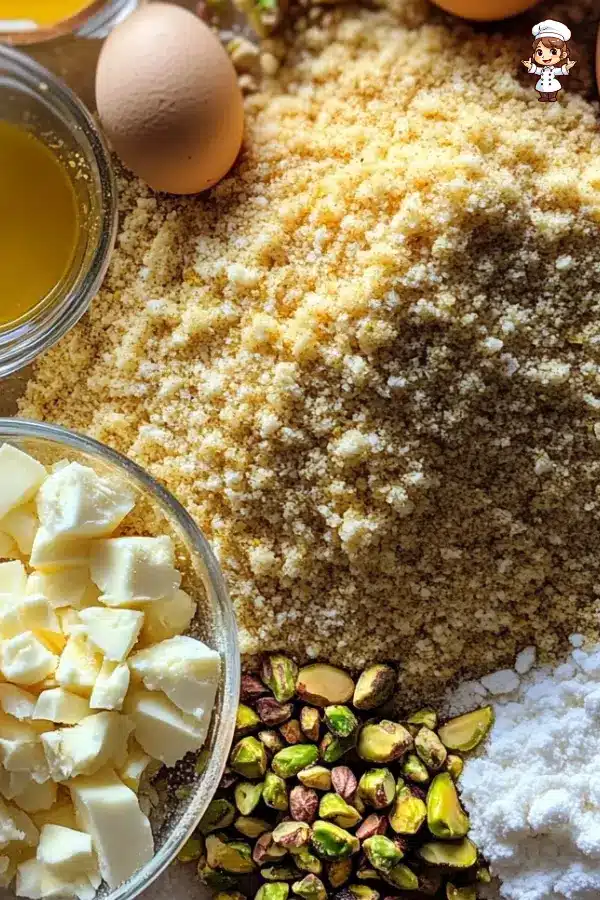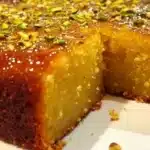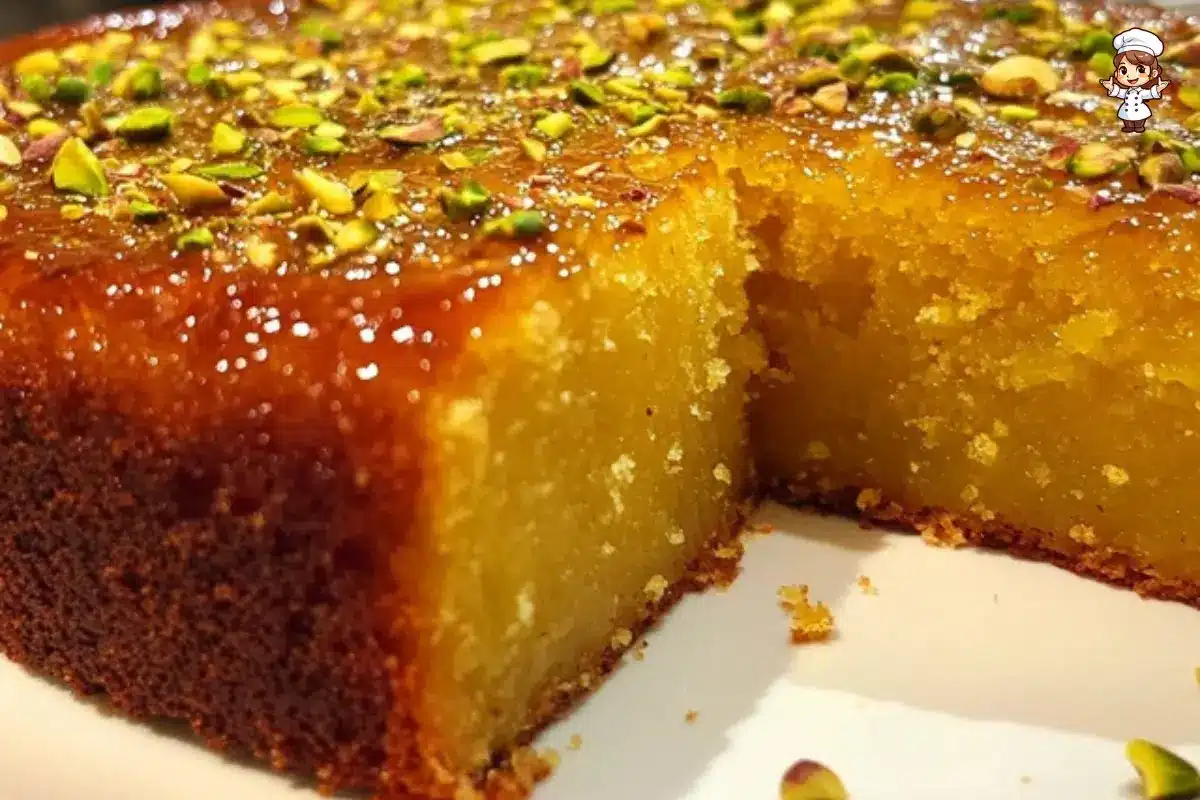Saffron Pistachio Basbousa is a deliciously aromatic Middle Eastern cake that has won the hearts of many across the world. This dessert brings together semolina, saffron, and pistachios to create a rich, fragrant cake soaked in a sweet syrup. It’s the perfect balance of flavors and textures—slightly crumbly, moist, and studded with crunchy pistachios. Whether you’re preparing it for a special occasion or just for a treat, this dessert will surely impress anyone who tastes it.
In this guide, we’ll take you through everything you need to know about Saffron Pistachio Basbousa, from its origins to the ingredients and, of course, a detailed recipe for making this delectable dessert at home. So, let’s dive in!
What is Basbousa?
Basbousa, also known as Hareeseh or Revani in different cultures, is a traditional semolina cake that originates from the Middle East. It’s typically made from semolina, sugar, yogurt, and sometimes coconut, then drenched in a sugar syrup. The Saffron Pistachio Basbousa version is a fragrant twist on the classic, adding two unique ingredients—saffron and pistachios.
This Middle Eastern cake is served as a dessert and has gained international popularity due to its delightful sweetness, soft texture, and rich flavor profile provided by saffron. When baked, it has a crumbly yet moist texture, and once soaked in syrup, it becomes even more indulgent. The addition of pistachios provides a wonderful crunch and richness that pairs perfectly with the syrup-soaked cake.
The Special Touch of Saffron and Pistachios

What makes the Saffron Pistachio Basbousa so special is its ability to elevate the standard semolina cake into something truly luxurious. Saffron, often regarded as the world’s most expensive spice, brings its golden hue and floral aroma to the cake. It not only enhances the flavor but also adds a visually striking appearance. The pistachios, on the other hand, lend both texture and taste, with their buttery flavor making every bite even more delightful.
This combination of saffron and pistachios transforms an otherwise simple dessert into something unique and extraordinary. Whether it’s a celebration or a casual treat, this cake is bound to steal the show.
Key Ingredients for Saffron Pistachio Basbousa

Semolina and Flour: The Foundation of Basbousa
The main ingredient in any Saffron Pistachio Basbousa is semolina, which gives the cake its signature texture. Semolina is made from durum wheat and has a slightly coarse texture that makes the cake dense and moist. It absorbs the syrup beautifully, ensuring that the Basbousa remains soft and sweet without becoming soggy. In this recipe, semolina is combined with all-purpose flour to balance the structure and tenderness of the cake. The flour helps make the cake a bit lighter, while the semolina gives it a satisfying bite.
The Magic of Saffron
Now, let’s talk about the star ingredient in Saffron Pistachio Basbousa—saffron. This golden spice isn’t just beautiful to look at; it also imparts a subtle floral flavor and an earthy aroma. Saffron is known for its health benefits as well, including its mood-lifting properties and antioxidant content. In the cake, it adds a distinct richness, and when paired with the syrup, it gives the Basbousa a luxurious, aromatic edge that’s hard to beat. Plus, the saffron’s vibrant yellow hue turns your Basbousa into a visually stunning dessert.
Pistachios for Texture and Taste
Pistachios in Saffron Pistachio Basbousa are more than just a garnish; they’re a key element that adds a delightful crunch to the soft, syrup-soaked cake. These nuts provide a unique buttery flavor and a subtle sweetness that pairs perfectly with the delicate saffron. Additionally, they complement the cake’s texture by offering a contrast to the smoothness of the semolina. Chopped pistachios are sprinkled on top before baking, but feel free to add more or even mix them into the batter for a richer experience.
Other Essential Ingredients
Aside from semolina, flour, saffron, and pistachios, the Saffron Pistachio Basbousa also requires basic baking ingredients like eggs, sugar, butter, milk, and rosewater. The eggs bind the ingredients together, while the butter ensures a moist cake. Rosewater, which adds a subtle floral note, enhances the Middle Eastern flavor profile. With all these ingredients combined, you get a cake that’s rich in flavor, moist in texture, and utterly delightful.
How to Make Saffron Pistachio Basbousa

Step-by-Step Guide
Making Saffron Pistachio Basbousa is relatively simple, though it requires some attention to detail. Start by preheating your oven to 350°F (175°C) and greasing a 9-inch cake pan. You want to make sure the pan is well-prepared so the cake comes out easily.
In a medium bowl, whisk together the semolina, all-purpose flour, baking powder, cardamom, and cinnamon. These dry ingredients set the stage for your cake’s texture and flavor. In another bowl, beat the eggs and sugar until smooth, then add the melted butter, milk, vanilla extract, and rosewater. Mix everything together until well combined. Now, gradually add the dry ingredients to the wet ingredients, stirring until you have a smooth batter.
Pour the batter into the prepared cake pan and spread it out evenly. Let the batter sit for about 10 minutes before placing it in the oven. This resting period helps the semolina absorb the liquid and ensures a fluffier cake. Bake the cake for 25-30 minutes, or until it turns golden brown and a toothpick inserted into the center comes out clean.
Making the Saffron Syrup
While the cake is baking, prepare the saffron syrup. In a small saucepan, combine sugar, water, saffron threads, and lemon juice. Bring the mixture to a boil, stirring to dissolve the sugar, then reduce the heat and let it simmer for 5-7 minutes. The syrup should thicken slightly but still be pourable. Once it’s ready, remove it from the heat and set it aside.
Pouring the Syrup and Garnishing with Pistachios
Once your Saffron Pistachio Basbousa has baked and is golden on top, remove it from the oven and immediately pour the saffron syrup over the hot cake. The syrup will soak into the semolina cake, making it even more moist and flavorful. Let the cake sit for about 10 minutes to absorb the syrup before cutting it into squares.
Finally, garnish your Basbousa with a generous sprinkling of chopped pistachios. This not only adds crunch but also gives the cake a beautiful finish. Now you’re ready to serve your Saffron Pistachio Basbousa to friends and family—prepare for compliments!
Print
Saffron Pistachio Basbousa Recipe: A Middle Eastern Delight
- Total Time: 50 minutes
- Yield: Serves 8
- Diet: Vegetarian
Description
Saffron Pistachio Basbousa is a luxurious Middle Eastern semolina cake that combines the rich flavors of saffron and the crunch of pistachios. Soaked in a fragrant saffron syrup, this cake is moist, flavorful, and visually stunning, making it a perfect dessert for any occasion. The unique blend of spices, combined with the buttery texture and aromatic saffron, creates a treat that’s both indulgent and satisfying. Whether you’re a seasoned baker or just trying your hand at Middle Eastern desserts, this Saffron Pistachio Basbousa recipe is easy to follow and results in a mouthwatering cake everyone will love.
Ingredients
- 200 g semolina (1 ¼ cups)
- 100 g all-purpose flour (¾ cup)
- 1 tsp baking powder
- 1 tsp ground cardamom
- 1 tsp ground cinnamon
- 150 g sugar (¾ cup)
- 2 large eggs
- 120 ml whole milk (½ cup)
- 100 g unsalted butter, melted (½ cup)
- 1 tsp vanilla extract
- 1 tbsp rosewater
- ¼ cup chopped pistachios for topping
For the saffron syrup:
- 100 g sugar (½ cup)
- 100 ml water (½ cup)
- 1 tsp saffron threads
- 1 tsp lemon juice
Instructions
- Preheat the oven to 350°F (175°C). Grease and line a 9-inch square or round cake pan.
- Mix dry ingredients: In a medium bowl, combine the semolina, flour, baking powder, cardamom, and cinnamon. Set aside.
- Whisk wet ingredients: In a large bowl, whisk together the eggs, sugar, melted butter, milk, vanilla extract, and rosewater until smooth.
- Combine wet and dry ingredients: Gradually add the dry mixture into the wet ingredients, stirring until well combined.
- Prepare the cake pan: Pour the batter into the prepared cake pan and spread it out evenly. Let it sit for 10 minutes to rest.
- Bake the Basbousa: Place the cake in the preheated oven and bake for 25-30 minutes, or until golden brown and a toothpick inserted into the center comes out clean.
- Prepare the saffron syrup: While the cake bakes, make the saffron syrup. In a small saucepan, combine the sugar, water, saffron threads, and lemon juice. Bring to a boil, then reduce the heat and simmer for 5-7 minutes until the syrup thickens slightly.
- Pour the syrup over the cake: Once the cake is done, remove it from the oven and immediately pour the saffron syrup evenly over the hot cake. Let it soak in and cool for about 10 minutes.
- Garnish and serve: Garnish the cake with chopped pistachios and cut into squares. Serve and enjoy!
Latest Amazon Finds
Notes
- For a more aromatic twist, you can add a bit of orange blossom water in place of or in addition to the rosewater.
- If you prefer a less sweet cake, reduce the sugar in the syrup by a quarter.
- This Saffron Pistachio Basbousa can be made in advance! It’s even better the next day when the flavors have had more time to meld.
- Prep Time: 20 minutes
- Cook Time: 30 minutes
- Category: Dessert, Cake
- Method: Baking
- Cuisine: Mediterranean, Middle Eastern
Nutrition
- Calories: 320 kcal
- Sugar: 22g
- Sodium: 70mg
- Fat: 18g
- Saturated Fat: 6g
- Unsaturated Fat: 12g
- Trans Fat: 0g
- Carbohydrates: 40g
- Fiber: 2g
- Protein: 6g
- Cholesterol: 45mg
Keywords: Saffron Pistachio Basbousa, semolina cake, Middle Eastern dessert, pistachio cake, saffron cake recipe, traditional Basbousa, Middle Eastern sweets
Variations of Saffron Pistachio Basbousa
Adding Rosewater for Fragrance
If you want to enhance the flavor profile of your Saffron Pistachio Basbousa, adding rosewater is an excellent option. Rosewater is commonly used in Middle Eastern desserts, and it imparts a delicate, floral fragrance that pairs beautifully with the richness of saffron. When combined with saffron, rosewater creates a fragrant and aromatic balance that elevates the dessert to another level. Just a teaspoon or two added to the batter can transform your Basbousa, giving it that authentic, exotic touch.
Using Coconut or Almonds
If you’re looking for a twist on the traditional Saffron Pistachio Basbousa, why not experiment with coconut or almonds? Some recipes call for coconut, which adds a tropical flair and extra moisture to the cake. You can fold the shredded coconut into the batter for a softer texture or sprinkle it on top for added flavor and crunch. Alternatively, almonds can be used as a garnish or mixed into the batter for an earthy, nutty taste. Both coconut and almonds blend well with the other ingredients, enhancing the overall texture and flavor of the cake.
Serving Suggestions
When it comes to serving your Saffron Pistachio Basbousa, the possibilities are endless. This cake pairs beautifully with a cup of Turkish coffee or mint tea, making it a perfect choice for an afternoon treat or dessert after dinner. You could also serve it alongside a dollop of whipped cream or a scoop of vanilla ice cream for a more indulgent experience. Regardless of how you serve it, one thing’s for sure—Saffron Pistachio Basbousa is bound to impress.
Saffron Pistachio Basbousa Around the World
Middle Eastern Influence
Basbousa has long been a beloved dessert in the Middle East, but the Saffron Pistachio Basbousa variation brings it to new heights. Traditionally, the cake is a staple in countries like Egypt, Lebanon, and Turkey, each adding their unique spin to the recipe. While the basic ingredients remain the same—semolina, syrup, and sometimes coconut—regional variations may include different syrups or spices. The addition of saffron and pistachios is a modern take, offering a richer flavor profile and more luxurious texture. Whether enjoyed as a special occasion dessert or a daily treat, Basbousa is an essential part of Middle Eastern culinary culture.
Basbousa in Modern Cooking
In today’s kitchens, Saffron Pistachio Basbousa has been reinvented in various ways. Bakers have experimented with gluten-free versions, using almond flour or oat flour as substitutes for semolina. Some have even made vegan versions by swapping eggs and dairy for plant-based alternatives. The cake is also commonly seen in bakeries worldwide, often served in bite-sized squares as a snack or dessert. As more people discover the magic of saffron and pistachios, this once-local treat has gained popularity in many international food circles.
For more delicious recipes, check out our recipe article that explores other unique Middle Eastern sweets.
Health Benefits of Saffron and Pistachios
Nutritional Benefits of Pistachios
When you enjoy a slice of Saffron Pistachio Basbousa, you’re not just indulging in a sweet treat—you’re also benefiting from the health perks of pistachios. These tiny nuts are packed with protein, fiber, and healthy fats, which can support heart health and help manage cholesterol levels. They’re also rich in antioxidants, which help fight free radicals and reduce inflammation in the body. Furthermore, pistachios are a good source of vitamins and minerals, including vitamin B6, copper, and magnesium, all of which play essential roles in maintaining a healthy immune system and boosting energy levels.
Saffron’s Medicinal Qualities
Saffron, the golden spice at the heart of Saffron Pistachio Basbousa, isn’t just prized for its unique flavor and color—it also has numerous health benefits. Research suggests that saffron may help improve mood and combat symptoms of depression, making it an excellent natural remedy for mental well-being. Additionally, saffron is believed to aid in digestion, improve memory, and even promote healthy skin. It’s a spice that’s not only a treat for your taste buds but also supports your overall health, making your dessert a little healthier than you might think!
Troubleshooting Common Basbousa Issues
Why is My Basbousa Too Dense?
If your Saffron Pistachio Basbousa turns out denser than expected, there could be a few reasons why. First, make sure you’re not overmixing the batter. Overmixing can cause the semolina to become too compact, making the cake heavy and dense. Another common mistake is using too much semolina or flour. The balance between the two is essential for getting that perfect light texture. Additionally, be sure to allow the batter to rest for a few minutes before baking; this gives the semolina time to absorb the moisture and results in a fluffier cake.
How to Avoid Over-Sweetening
One of the key features of Saffron Pistachio Basbousa is its syrup-soaked texture, but sometimes, the syrup can be a bit too sweet. To avoid over-sweetening your cake, be mindful of the amount of sugar you use in both the cake and the syrup. The syrup should be poured gently and evenly, allowing the cake to absorb just the right amount. If you prefer a less sweet version, you can reduce the sugar in the syrup by about a quarter without sacrificing the cake’s characteristic moistness. This will help maintain the balance of flavors without overwhelming the palate.
FAQs About Saffron Pistachio Basbousa
Can I Make Basbousa Without Saffron?
While Saffron Pistachio Basbousa is known for its distinctive flavor and golden color from saffron, you can still make a delicious version without it. If you don’t have saffron on hand or prefer not to use it, you can replace it with a pinch of turmeric for the color or simply skip it altogether. The cake will still be moist and sweet, but you’ll lose the signature aroma that saffron imparts. If you’re looking to maintain the floral notes, a dash of rosewater or orange blossom water could work wonders in place of saffron.
Can I Make Basbousa in Advance?
Yes, Saffron Pistachio Basbousa can be made in advance! In fact, it’s often better the next day when the flavors have had more time to meld. After baking and soaking it in the saffron syrup, let the cake cool completely. Then, cover it tightly with plastic wrap or store it in an airtight container. It will stay fresh for several days, making it a perfect dessert to prepare ahead of time for a party or gathering. If you want to enjoy it warm, simply reheat individual pieces in the microwave for a few seconds.



